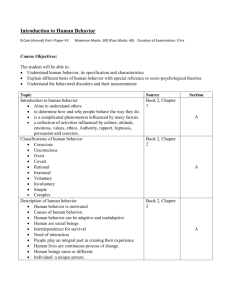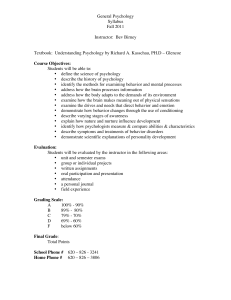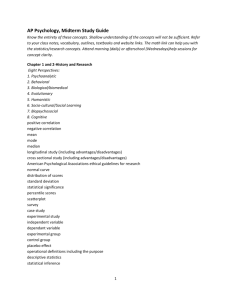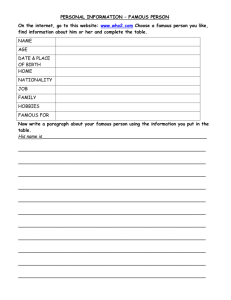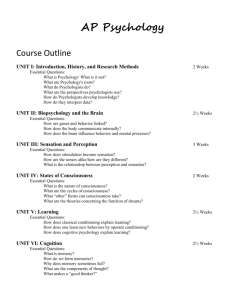Comprehensive Final Exam Review
advertisement
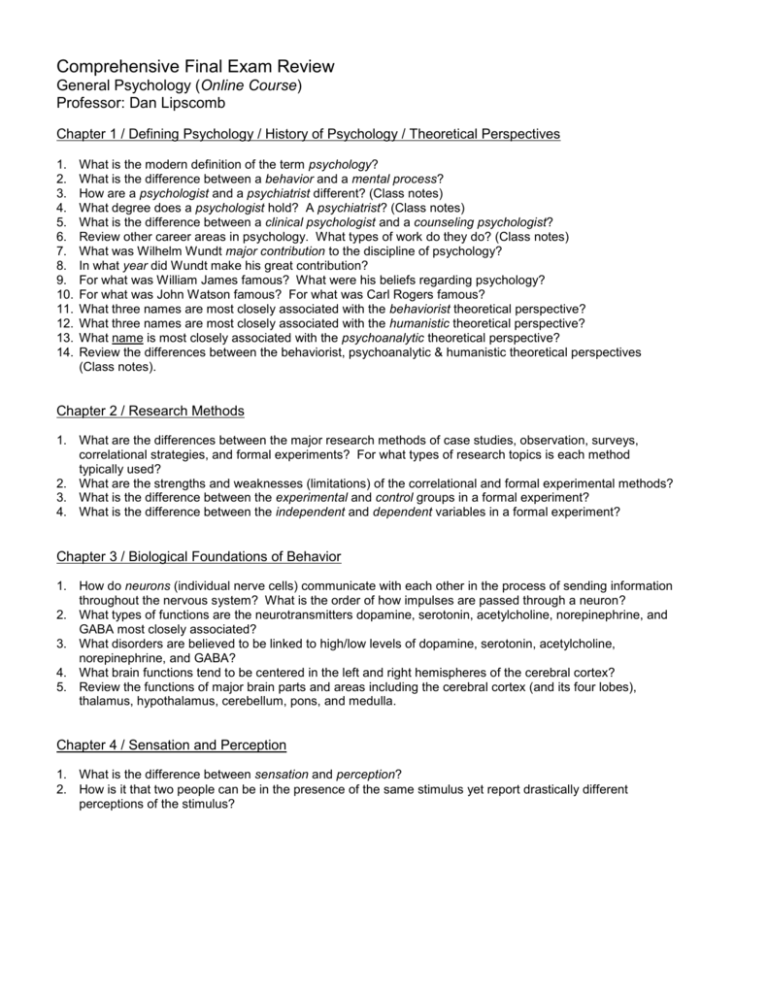
Comprehensive Final Exam Review General Psychology (Online Course) Professor: Dan Lipscomb Chapter 1 / Defining Psychology / History of Psychology / Theoretical Perspectives 1. 2. 3. 4. 5. 6. 7. 8. 9. 10. 11. 12. 13. 14. What is the modern definition of the term psychology? What is the difference between a behavior and a mental process? How are a psychologist and a psychiatrist different? (Class notes) What degree does a psychologist hold? A psychiatrist? (Class notes) What is the difference between a clinical psychologist and a counseling psychologist? Review other career areas in psychology. What types of work do they do? (Class notes) What was Wilhelm Wundt major contribution to the discipline of psychology? In what year did Wundt make his great contribution? For what was William James famous? What were his beliefs regarding psychology? For what was John Watson famous? For what was Carl Rogers famous? What three names are most closely associated with the behaviorist theoretical perspective? What three names are most closely associated with the humanistic theoretical perspective? What name is most closely associated with the psychoanalytic theoretical perspective? Review the differences between the behaviorist, psychoanalytic & humanistic theoretical perspectives (Class notes). Chapter 2 / Research Methods 1. What are the differences between the major research methods of case studies, observation, surveys, correlational strategies, and formal experiments? For what types of research topics is each method typically used? 2. What are the strengths and weaknesses (limitations) of the correlational and formal experimental methods? 3. What is the difference between the experimental and control groups in a formal experiment? 4. What is the difference between the independent and dependent variables in a formal experiment? Chapter 3 / Biological Foundations of Behavior 1. How do neurons (individual nerve cells) communicate with each other in the process of sending information throughout the nervous system? What is the order of how impulses are passed through a neuron? 2. What types of functions are the neurotransmitters dopamine, serotonin, acetylcholine, norepinephrine, and GABA most closely associated? 3. What disorders are believed to be linked to high/low levels of dopamine, serotonin, acetylcholine, norepinephrine, and GABA? 4. What brain functions tend to be centered in the left and right hemispheres of the cerebral cortex? 5. Review the functions of major brain parts and areas including the cerebral cortex (and its four lobes), thalamus, hypothalamus, cerebellum, pons, and medulla. Chapter 4 / Sensation and Perception 1. What is the difference between sensation and perception? 2. How is it that two people can be in the presence of the same stimulus yet report drastically different perceptions of the stimulus? Chapter 5 / Consciousness, Sleep and Dreams 1. 2. 3. 4. 5. How do psychologists define the term consciousness? What brain waves are associated with various states of consciousness? What are the common cognitive and physiological characteristics of the sleep stages (1 – 4 & REM)? In terms of sleep stages, how does a typical night of sleep unfold and progress? Is there general agreement between psychologists regarding the nature of dreams? How does the dream theory of Freud (Psychoanalytic) differ from the theory of Hobson & McCarley (Activation-Synthesis? Chapter 6 / Learning 1. How is learning defined? 2. What are the key differences between classical conditioning and operant conditioning? 3. Differentiate the four key elements of classical conditioning (UCS, CS, UCR, CR). Understand and note examples of each. 4. What is the difference between the four types of operant conditioning including positive reinforcement, negative reinforcement, punishment and extinction? Understand and note examples of each. How does each type of operant conditioning change the frequency of behavior (increase or decrease)? 5. What are the advantages and disadvantages of disciplining a child with positive reinforcement or punishment? 6. For what is Ivan Pavlov most famous? For what is B.F. Skinner most famous? Chapter 7 / Memory 1. What are the characteristics (function, duration, capacity) of sensory memory, short-term memory and longterm memory as defined in the classic three-stage memory theory? (Text and class notes) 2. Of all the long-term memory encoding processes, which seem to be the most powerful and effective? 3. Review conclusions on eyewitness memory (and testimony) and the reconstructive nature of long-term memory. Chapter 9 / Intelligence 1. How is intelligence defined? 2. What is the traditional view (the g-factor theory and those that propose only verbal, mathematical and spatial skills) of intelligence and how does it differ from the more contemporary views of theorists like Gardner and Sternberg? 3. When a psychological test is said to have validity, what does that mean? What does it mean when a test is said to have reliability? 4. Note the names of commonly used professional intelligence tests like the Stanford-Binet, WAIS-III, and WISC-III. For what age group is each designed? 5. Who created the first fairly reliable test of intelligence? Chapter 10 / Motivation and Emotion 1. 2. 3. 4. 5. Define and differentiate the terms motivation and emotion. Understand the various factors involved in motivation. What are the five levels of Maslow’s Hierarchy of Needs (in order from lowest to highest)? What are the generally agreed upon six universal emotions? Review and differentiate the classic theories of emotion (James-Lange, Cannon-Bard, etc…) Chapter 11 / Developmental Psychology 1. For what is Jean Piaget famous? 2. Understand the key developmental crises that define each of Erik Erikson’s stages of psychosocial development. Chapter 12 / Personality Theory 1. How is personality defined? 2. What are the major influences that form and shape the human personality? 3. How did Freud characterize the human personality? Id, ego, superego? Conscious, preconscious, unconscious? What are the five stages of psychosexual development according to Freud? 4. How did Carl Rogers characterize the human personality? What was the source of most human maladjustment according to Rogers’ theory? 5. For what is Carl Jung most famous? For what is Alfred Adler most famous? 6. What is the difference between the two major types of personality tests including the objective tests and the projective tests? What are examples of objective and projective tests? Chapter 13 / Stress and Health 1. What is stress? How is stress defined? 2. What are the four major sources of stress? Note examples of each. Chapter 14 / Mental Disorders 1. Differentiate the two major concepts of abnormal behavior including atypical behavior and maladaptive behavior. Note examples of each. 2. What are the major diagnostic features of the three major mental disorders including major depression, bipolar disorder and schizophrenia? 3. What are the three primary subtypes of schizophrenia? 4. Review major types of personality disorders. 5. What are common myths about schizophrenia and mentally disordered persons in general? Chapter 15 / Therapies 1. What are the three major forms of therapy? 2. What are the characteristic differences between psychoanalysis, person (client)-centered therapy, cognitive therapy, and behavior therapy? What theorist names are associated with each? 3. What types of medications are used to treat the different types of mental disorders? 4. For what is ECT (Electroconvulsive Therapy) most commonly used today? Chapter 16 / Social Psychology 1. 2. 3. 4. 5. 6. 7. What is the main idea behind the cognitive dissonance theory? What is the difference between the social forces of conformity and obedience? What conditions and situational variables tend to facilitate altruistic or helping behavior? For what is Stanley Milgram most famous? What is the main idea behind attribution theory? What are common attribution biases? Review group processes such as polarization, groupthink, etc… Review the general characteristics of interpersonal attraction. What attracts us to others?

